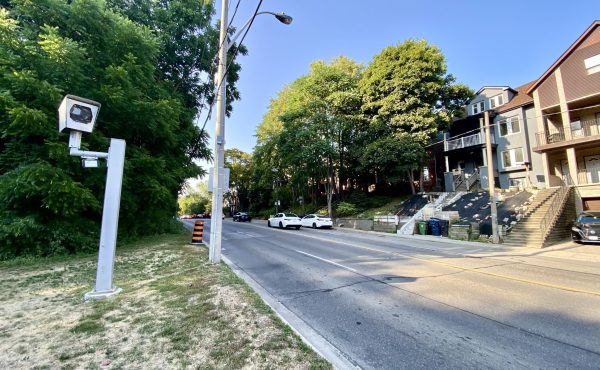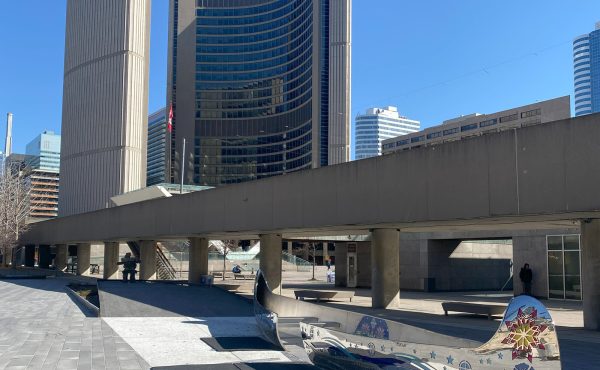
I am fascinated by signs on our streets. This fascination, though, often leads me to frustration in Toronto.
A case in point is the use of the sign Please Drive Slowly accompanied by an image of a turtle; it may be the most ridiculous piece of metal in use by the City’s transportation department. It is often found around schools or in sleepy neighbourhoods where kids can be found playing near the street or where there is a hospital or retirement home. The example shown above — found at College and St. George on the edge of the University of Toronto’s downtown campus — is a glaring example of Toronto’s unflinching obsession with rules and signage (not to mention signage clutter, as seen by a second group of signs tucked in behind the turtle).
The speed here drops to 30km/hr, which makes sense with all the pedestrian traffic flowing in and out of buildings of the St. George campus. But is this the best way to indicate to a driver that they should slow down? I’d say no. Can a single and much better designed sign do the trick instead of three? That would be an emphatic yes.
The turtle sign, no matter how charming or cute, really has no place on our roads. A driver does not have time to examine the detailed image of the turtle to figure out what it is (if the sign-makers *really* needed to use a turtle a pictograph or silhouette would be more ideal). In a multicultural city like Toronto does a turtle represent slowness to most people? And with a warning sign that clearly states TRAFFIC CALMING ZONE, isn’t the turtle image just redundant? And what about the typography? An italicized version of the font Cooper — or some knock-off version — can only be described as a very poor choice.
Obviously, signage is needed in this area because the climate for drivers changes once you enter the roads of U of T. But what type of signs could be used?
Below are two examples of signs I stumbled across while on vacation in Gothenburg, Sweden last year. They are placed low and near the curb in a much different place than speed limits. Also notice how they treat the colour of the sign; In Toronto, we use a gold and black, diamond-shaped warning sign for pedestrians, while in Europe they use the blue background. In the world of street signs, blue is symbolic of a positive action, the opposite of a warning, kind of like how Toronto bike lanes are demarcated.



The above sign is the standard used for shared streets in Europe (this photo was taken in Malmo, Sweden). While St. George Street is not a shared street (though there are plans to pedestrianize parts of it), a modified sign of this nature, indicating the large presence of pedestrians, could be a practical alternative to Toronto’s practice of inconsistent and cluttered signage.




15 comments
The turtle sign always bring a smile to my face…it’s just so silly. Having said that, the clutter of signs that we have throughout the city is ridiculous and it’s not that effective as a sign. I’d love to see the European installations on our streets.
If they do get removed, I’d love to snag one of them.
I don’t have an image link handy but Peel Region’s sign is even more rediculous.
What are the plans to pedestrianize parts of St. George?
I like the silliness of the turtle. The blue signs are much more obtuse and confusing to me. Agree that 3 signs is overkill – would vote off the Traffic Calming sign before the turtle though.
Here is a link to the St George pedestrian plans:
http://www.utoronto.ca/openspace/Project%20Info/pedpriority.htm
When I was in Austria 15 years ago, the quiet rural roads had village signs exclaiming “Achtung! Kinder” (leading to an inevitable mental association with a certain U2 album). Each sign would have an illustration of a child running with a shocked expression on his face. Several hundred meters later, as one exited the village, one would see a similar sign with a close-up of the child smiling, exclaiming “Danke!”
I remember my first impression of the turtle sign was that it seemed kind of awkward. However it has grown on me, to the point that I take offense to the heading (although I do appreciate the play on words).
One thing I like about the turtle is how it works on two levels — the slow pace of the turtle, and the shape of its shell represents the speed humps. (Drive slowly — turtles in the road!)
The “shared street” sign means something different (shared streets, rather than speed humps). I have never been fond of it, although the Swedish example is a little better with the more realistic depictions of people/objects.
The Peel example that someone referred to is probably the Mississauga sign saying “Drive Slowly / Think Of Me” with a drawing some 6-year-old did of a kid on a bike. It’s been replaced with this version.
Toronto has too much sign pollution. Not the advertising kind, but the regulating kind. The signage on St. Clair Avenue West is a mess. Duplicate traffic lights for regular lights, duplicate traffic lights along with English explanation for left turn and U-turns, duplicate traffic lights for transit along with English explanation, other signage to explain what the right-of-way is for, and so on and so on.
The signage in Europe is much more simpler and less glaring. And most of it is not in any language. Unfortunately, sign regulation is under the control of Ontario, and they take forever to make changes. European signage should be the example to be followed, not the wordy and mushroomy signs we have here.
Most people understand that red means stop and green means go. So why are EXIT signs red? There is no thought given into the making of signs, just add more to keep themselves out of trouble.
I find them charming, but yeah, probably not the best choice for a traffic sign. Especially hiding in that forest of different signs. At under 30 km/h they might be safely readable, but it’s the folks who are going faster than that at whom they’re really directed.
Have to disagree with you on the silhouette turtle vs. cartoon turtle though. Sometimes simplification makes things more legible, sometimes it doesn’t… it would take me a lot more effort to figure out what a black turtle silhouette was (reversing car with attached trailer?) than the cartoony picture does.
On the subject of sign clutter, I have noticed a lot of recently installed street signs on their very own free-standing slim metal pole when there is a perfectly good existing pole less than a metre away. I am so glad that the city has so much money sitting in the till to waste on this type of setup (and many other cases where there are one or more superfluous poles).
Child poverty I hope is job 2 after we solve the turtle sign menace.
Signs always seem to be the worst way to get someone to behave. They only work if someone notices them and then chooses to behave.
If we want the traffic to slow down, why not calm it? You can’t ignore speed bumps and rumble strips, etc.
I should add that I too find the turtle sign cute. I just don’t think it should be used as a top-level traffic sign.
My favourite example of an incomprehensible sign are the tiny little “Bay Street Clearway” signs with arrows on them. I understand their point is to reserve the right lane for buses, cabs or cars about to turn right, but boy, they sure are hard to understand and harder to see.
Signs in San Francisco
http://www.youtube.com/watch?v=NINOxRxze9k&playnext_from=TL&videos=8tffSl1HBXw